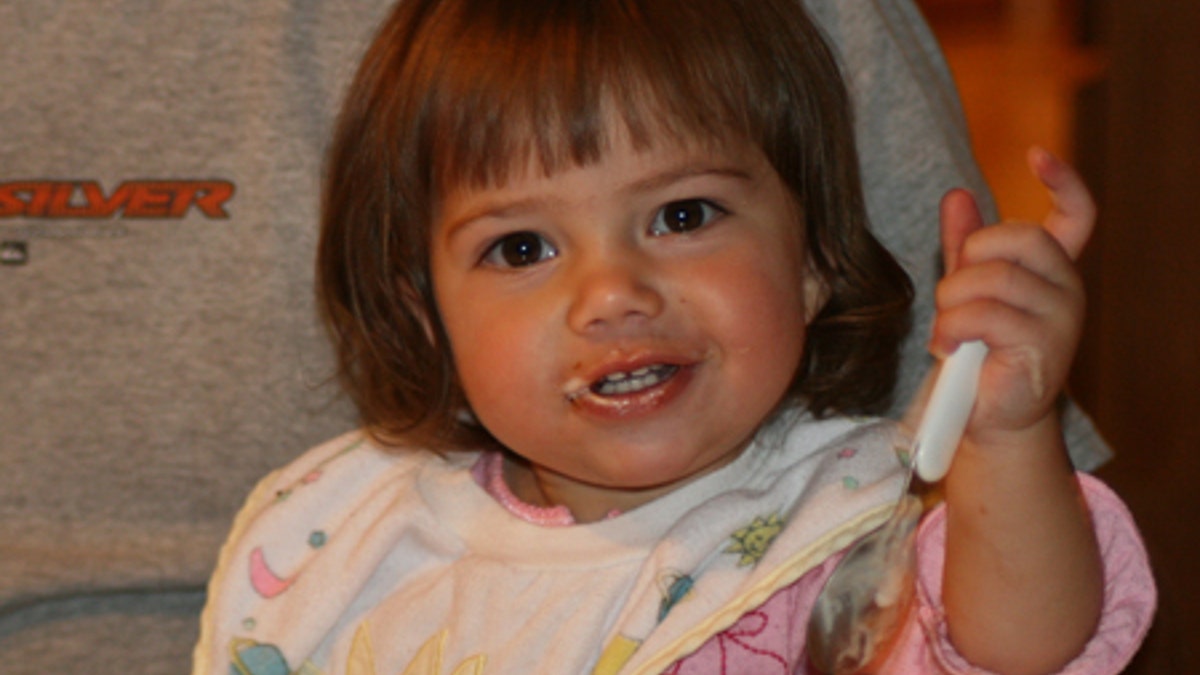
Chloe Levine, today, at 3 1/2 (Courtesy of Jenny Levine)
Chloe Levine was born seemingly perfect — she was the happy and healthy baby her parents had dreamed of.
But by the time she was 9 months old, Chloe was not reaching the milestones her older sister Shayla had met at that age.
Chloe’s right hand was constantly clenched in a tight fist – she couldn’t even hold her bottle. And she wasn’t able to crawl; she would "shuffle" her body across the floor in a seated position, her mother, Jenny, recalls.
Soon after Chloe’s first birthday, the Levines, who live in Denver, learned their daughter had suffered a stroke in utero and had become afflicted with cerebral palsy.
VIDEO: Click here to learn more about Chloe Levine
"A part of me just died," Jenny Levine said. "At that point there was no cure for her, no treatment other than therapies – speech, physical and occupational therapy for the next 18 years. As parents, that was not fine. We wanted her to have as normal a life as possible; we didn’t want her to face a life of disability."
The Levines remembered they had banked stem cells from Chloe’s umbilical cord at her birth, and wondered if they could be used to help treat her.
Stem cells from bone marrow have been used in medicine for about 40 years, primarily in the treatment of blood diseases, cancers and immune disorders, said David Zitlow, vice president of corporate communications at Cord Blood Registry, the world’s largest cord blood bank. Stem cells have been known to jumpstart a person’s immune system, especially after an intense round of chemotherapy.
But there are advantages to using stem cells from your own umbilical cord – the cells are younger, they have not been exposed to environmental factors like viruses or chemicals, which can alter the cell’s structure and function – and if you are using your own cord blood cells, your body can’t reject them, Zitlow said.
The collection process at birth is simple: Once the baby is born, the blood is drawn from the umbilical cord with a syringe, placed in a special bag and sent to the parents’ blood bank of choice to be stored indefinitely. It’s not painful, unlike collecting cells from the bone marrow.
Zitlow said that science has shown the umbilical cord cells are smart – once they are reinfused into the body, they migrate to the exact spot of injury and help the damaged cells or tissue repair itself.
The Levines were in luck: Dr. Joanne Kurtzberg, a professor of pediatrics and pathology at Duke University, was conducting a study where children with cerebral palsy were injected with their own cord blood cells.
On May 28, 2008, at the age of 2, Chloe received a 15-minute re-infusion of her stem cells.
"The doctor is really cautious about what she tells patients," Jenny Levine said. "She didn’t have a whole lot of results coming in. The best case scenario, we’d see signs of improvement in six months to a year."
Within four days, her parents saw a noticeable difference, although Kurtzberg said most kids show benefits three to nine months later.
The rigidity on Chloe’s right side loosened up and her speech started to improve. She was able to ride her toy tractor, which in the past had been too difficult for her to pedal.
"Her life is completely normal, she doesn’t drag her right foot, she can use her right hand," Jenny Levine said. "She rides a bike, a scooter…we’re taking her skiing this year. She’s fabulous."
At this time, Kurtzberg said she does not know how long the effects of cord blood will last on kids like Chloe, but if there is a good chance it will be "durable and last indefinitely." This is essential, since most babies have enough cells for only one infusion.
Doctors are currently researching the effects of umbilical cord cells and their effects on brain injuries, type I diabetes, neurology and cardiology. Kurtzberg is also studying cord blood infusions on babies with birth asphyxis (hypoxic ischemic encephalopathy, which is damage to the central nervous system due to a lack of oxygen. It often leads to developmental delays) and babies with congenital hydrocephalus (an excess of cerebrospinal fluid on the brain at birth).
In the near future, Kurtzberg will conduct a randomized trial to objectively determine if cord blood cell infusions are beneficial to kids like Chloe, or if other factors play a role in their success.
Dr. Charles Cox, from the University of Texas-Houston Medical School, has been studying cord blood cells for the past 2 1/2 years.
"Umbilical cord blood cell therapy for traumatic brain injury has a lot of pre-clinical work that has been done, suggesting that it’s beneficial," Cox said. "I believe that cord blood is equivalent or better than bone marrow-derived cells."
Cox said if the parents do not choose to save the cord blood, it is considered medical waste and thrown away.
"Really, the issue of cord blood banking today comes down to trying to understand what the future holds in terms of regenerative medicine as a field," Cox said. "So, the long-term look is, and even the intermediate-term look is that it’s not science-fiction. I see it expanding and accelerating over the next two to five years."
